Slynurse
On this page, you find all documents, package deals, and flashcards offered by seller Slynurse.
- 207
- 0
- 7
Community
- Followers
- Following
214 items
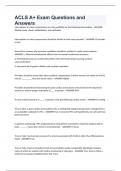
ACLS A+ Exam Questions and Answers
Interruptions in chest compressions are only justifiable for the following interventions - ANSWER-Rhythm/pulse checks, defibrillation, and intubation Interruptions in chest compressions should be limited to how many seconds? - ANSWER-10 seconds or less Name three reasons why excessive ventilation should be avoided in cardiac arrest patients - ANSWER-1. Adverse hemodynamic effects from increased intrathoracic pressures 2. Potential decreases in cerebral blood flow when the PaCO2 drops (ca...
- Package deal
- Exam (elaborations)
- • 14 pages •
Interruptions in chest compressions are only justifiable for the following interventions - ANSWER-Rhythm/pulse checks, defibrillation, and intubation Interruptions in chest compressions should be limited to how many seconds? - ANSWER-10 seconds or less Name three reasons why excessive ventilation should be avoided in cardiac arrest patients - ANSWER-1. Adverse hemodynamic effects from increased intrathoracic pressures 2. Potential decreases in cerebral blood flow when the PaCO2 drops (ca...

ACLS Exam Questions and Top Accurate Answers
What are the H's of Cardiac Arrest? - ANSWER-Hypovolemia Hypoxia Hydrogen Ion (Acidosis) Hyper/Hypokalemia Hypothermia Hypoglycemia What are the T's of Cardiac Arrest - ANSWER-Toxins (Overdose) Tamponade (Cardiac) Tension Pneumothorax Trauma Thrombosis How do you manage a V-Fib/Pulseless V-Tach Arrest? - ANSWER-If Witnessed, Defibrilate ASAP If Un-Witnessed, CPR for 5 Cycles/2 Minutes Defibrillate at Manufacturer's Recommendation Establish IV/IO ASAP Epinephrine 1mg IVP AS...
- Package deal
- Exam (elaborations)
- • 4 pages •
What are the H's of Cardiac Arrest? - ANSWER-Hypovolemia Hypoxia Hydrogen Ion (Acidosis) Hyper/Hypokalemia Hypothermia Hypoglycemia What are the T's of Cardiac Arrest - ANSWER-Toxins (Overdose) Tamponade (Cardiac) Tension Pneumothorax Trauma Thrombosis How do you manage a V-Fib/Pulseless V-Tach Arrest? - ANSWER-If Witnessed, Defibrilate ASAP If Un-Witnessed, CPR for 5 Cycles/2 Minutes Defibrillate at Manufacturer's Recommendation Establish IV/IO ASAP Epinephrine 1mg IVP AS...
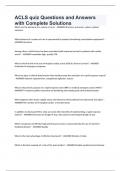
ACLS quiz Questions and Answers with Complete Solutions
Which are the elements of a system of care? - ANSWER-Structure, processes, system, patient outcome What element of a system of care is represented by properly functioning resuscitation equipment? - ANSWER-Structure Among others, which factor has been associated with improved survival in patients with cardiac arrest? - ANSWER-Immediate high- quality CPR What is the first link in the out-of-hospital cardiac arrest (OHCA) chain of survival? - ANSWER-Activation of emergency response Wha...
- Package deal
- Exam (elaborations)
- • 17 pages •
Which are the elements of a system of care? - ANSWER-Structure, processes, system, patient outcome What element of a system of care is represented by properly functioning resuscitation equipment? - ANSWER-Structure Among others, which factor has been associated with improved survival in patients with cardiac arrest? - ANSWER-Immediate high- quality CPR What is the first link in the out-of-hospital cardiac arrest (OHCA) chain of survival? - ANSWER-Activation of emergency response Wha...
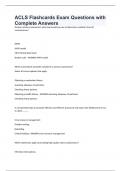
ACLS Flashcards Exam Questions with Complete Answers
During a primary assessment, what tool would you use to determine a patient's level of consciousness? NIHSS AVPU model Mini-Mental State Exam Braden scale - ANSWER-AVPU model Which assessments would be included in a primary assessment? Select all correct options that apply. Obtaining a medication history Assessing adequacy of perfusion Checking airway patency Obtaining a health history - ANSWER-Assessing adequacy of perfusion Checking airway patency A concept that helps...
- Package deal
- Exam (elaborations)
- • 53 pages •
During a primary assessment, what tool would you use to determine a patient's level of consciousness? NIHSS AVPU model Mini-Mental State Exam Braden scale - ANSWER-AVPU model Which assessments would be included in a primary assessment? Select all correct options that apply. Obtaining a medication history Assessing adequacy of perfusion Checking airway patency Obtaining a health history - ANSWER-Assessing adequacy of perfusion Checking airway patency A concept that helps...

AHA ACLS Exam Questions and Solved Answers
You find an unresponsive pt. who is not breathing. After activating the emergency response system, you determine there is no pulse. What is your next action? - ANSWER-Start chest compressions of at least 100 per min. You are evaluating a 58 year old man with chest pain. The BP is 92/50 and a heart rate of 92/min, non-labored respiratory rate is 14 breaths/min and the pulse O2 is 97%. What assessment step is most important now? - ANSWER-Obtaining a 12 lead ECG. Identification of Chest Disc...
- Package deal
- Exam (elaborations)
- • 12 pages •
You find an unresponsive pt. who is not breathing. After activating the emergency response system, you determine there is no pulse. What is your next action? - ANSWER-Start chest compressions of at least 100 per min. You are evaluating a 58 year old man with chest pain. The BP is 92/50 and a heart rate of 92/min, non-labored respiratory rate is 14 breaths/min and the pulse O2 is 97%. What assessment step is most important now? - ANSWER-Obtaining a 12 lead ECG. Identification of Chest Disc...
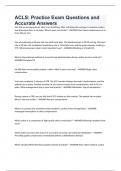
ACLS: Practice Exam Questions and Accurate Answers
You find an unresponsive pt. who is not breathing. After activating the emergency response system, you determine there is no pulse. What is your next action? - ANSWER-Start chest compressions of at least 100 per min. You are evaluating a 58-year-old man with chest pain. The blood pressure is 92/50 mm Hg, the heart rate is 92/min, the nonlabored respiratory rate is 14 breaths/min, and the pulse oximetry reading is 97%. What assessment step is most important now? - ANSWER-Obtaining a 12 lead E...
- Package deal
- Exam (elaborations)
- • 14 pages •
You find an unresponsive pt. who is not breathing. After activating the emergency response system, you determine there is no pulse. What is your next action? - ANSWER-Start chest compressions of at least 100 per min. You are evaluating a 58-year-old man with chest pain. The blood pressure is 92/50 mm Hg, the heart rate is 92/min, the nonlabored respiratory rate is 14 breaths/min, and the pulse oximetry reading is 97%. What assessment step is most important now? - ANSWER-Obtaining a 12 lead E...
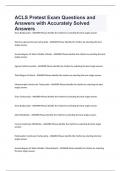
ACLS Pretest Exam Questions and Answers with Accurately Solved Answers
Sinus Bradycardia - ANSWER-Please identify the rhythm by selecting the best single answer. Reentry supraventricular tachycardia - ANSWER-Please identify the rhythm by selecting the best single answer. Second-degree AV block (Mobitz II block) - ANSWER-Please identify the rhythm by selecting the best single answer. Agonal rhythm/asystole - ANSWER-Please identify the rhythm by selecting the best single answer. Third-Degree AV block - ANSWER-Please identify the rhythm by selecting the b...
- Package deal
- Exam (elaborations)
- • 7 pages •
Sinus Bradycardia - ANSWER-Please identify the rhythm by selecting the best single answer. Reentry supraventricular tachycardia - ANSWER-Please identify the rhythm by selecting the best single answer. Second-degree AV block (Mobitz II block) - ANSWER-Please identify the rhythm by selecting the best single answer. Agonal rhythm/asystole - ANSWER-Please identify the rhythm by selecting the best single answer. Third-Degree AV block - ANSWER-Please identify the rhythm by selecting the b...
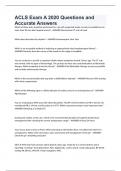
ACLS Exam A 2020 Questions and Accurate Answers
Which of these tests should be performed for a pt with suspected stroke as early as possible but no more than 20 min after hospital arrival? - ANSWER-Noncontrast CT scan of head Which best describes this rhythm? - ANSWER-Monomorphic Vent Tach Which is an acceptable method of selecting an appropriately sized oropharyngeal airway? - ANSWER-Measure from the corner of the mouth to the angle of mandible You are caring for a pt with a suspected stroke whose symptoms started 2 hours ago. The C...
- Package deal
- Exam (elaborations)
- • 6 pages •
Which of these tests should be performed for a pt with suspected stroke as early as possible but no more than 20 min after hospital arrival? - ANSWER-Noncontrast CT scan of head Which best describes this rhythm? - ANSWER-Monomorphic Vent Tach Which is an acceptable method of selecting an appropriately sized oropharyngeal airway? - ANSWER-Measure from the corner of the mouth to the angle of mandible You are caring for a pt with a suspected stroke whose symptoms started 2 hours ago. The C...
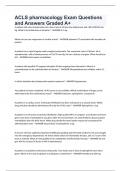
ACLS pharmacology Exam Questions and Answers Graded A+
A patient with sinus bradycardia and a heart rate of 42 bpm has diaphoresis and a BP of 80/60 mm Hg. What is the initial dose of atropine? - ANSWER-0.5 mg When can you use magnesium in cardiac arrest? - ANSWER-pulseless VT associated with torsades de pointes A patient has a rapid irregular wide-complex tachycardia. The ventricular rate is 138/min. He is asymptomatic, with a blood pressure of 110/70 mm Hg. He has a history of angina. What should you do? - ANSWER-Seek expert consultation ...
- Package deal
- Exam (elaborations)
- • 3 pages •
A patient with sinus bradycardia and a heart rate of 42 bpm has diaphoresis and a BP of 80/60 mm Hg. What is the initial dose of atropine? - ANSWER-0.5 mg When can you use magnesium in cardiac arrest? - ANSWER-pulseless VT associated with torsades de pointes A patient has a rapid irregular wide-complex tachycardia. The ventricular rate is 138/min. He is asymptomatic, with a blood pressure of 110/70 mm Hg. He has a history of angina. What should you do? - ANSWER-Seek expert consultation ...
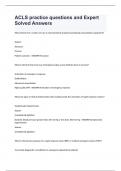
ACLS practice questions and Expert Solved Answers
What element of a system of care is represented by properly functioning resuscitation equipment? System Structure Process Patient outcome - ANSWER-Structure What is the first link in the out-of-hospital cardiac arrest (OHCA) chain of survival? Activation of emergency response Defibrillation Advanced resuscitation High-quality CPR - ANSWER-Activation of emergency reponse What are signs of clinical deterioration that would prompt the activation of rapid response system? Sy...
- Package deal
- Exam (elaborations)
- • 22 pages •
What element of a system of care is represented by properly functioning resuscitation equipment? System Structure Process Patient outcome - ANSWER-Structure What is the first link in the out-of-hospital cardiac arrest (OHCA) chain of survival? Activation of emergency response Defibrillation Advanced resuscitation High-quality CPR - ANSWER-Activation of emergency reponse What are signs of clinical deterioration that would prompt the activation of rapid response system? Sy...
